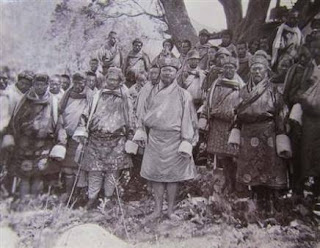The battle of changlimithang: The last struggle for Peace
Changlimithang, the only national stadium in the country, shares all the historical and political importance. It was a battle ground then, and the assassination ground where Chabda Namgay Bahadur and his allies where shot publicly for murdering Lyonchen Jigme Palden Dorji in Phuntsholing. It is now the celebration ground (where many national celebrations were done), national football ground and has become the favorite place for sports enthusiasts.
Changlimithang Today (Picture courtesy: Gettyimages)
During assassination Of Chabda (Picture Courtesy: Nari Rustomji)
Briefly, I will give the brief account on Battle of Changlimithang below.
It was during the time of Trongsa Poenlop Ugyen Wangchuck, where he faced the rebellion of his two adopted brothers Alu Dorji(Thimphu Dzongpoen) and Phuntsho Dorji(Punaka Dzongpoen then). It was the last internal political struggle that the King Ugyen Wangchuck have to face. The battle also marked the end of internal fueds.
The several causes that triggered the battle were: Alu Dorji and Phuntsho Dorji enthroned their own nominee as the new Desi despite the presence of reigning Desi on the throne. They enthroned the new Desi without informing the then Trongsa Poenlop Ugyen Wangchuck whuich was an open act of rebellion to Poenlop Ugyen Wangchuck. Besides that, the duo bribed the Trongsa Dronyer and framed the assassination conspiracy to assassinate Trongsa Poenlop. It proved futile when the loyal Dronyer revealed the conspiracy to Trongsa Poenlop. Despite such actions, Trongsa Poenlop Ugyen Wangchuck did not resort to immediate action in favour of not disturbing the internal stability and to avoid causing havoc and sufferings on the people. He indeed called the duo for peaceful negotiation, where they agreed to meet at Shar. When Trongsa Poenlop made his presence in Shar as agreed, Alu Dorji and Phuntsho Dorji failed to come; this was very insulting on Trongsa Poenlop. This acts infuriated Poenlop Ugyen Wangchuck and decided to take an immediate action against the duo.
In the series of events happened; Trongsa Poenlop led a troops of 2140 from his region in Trongsa (Sharchog khorlo Tshibgye) and marched to Punakha, where two consecutive battle were fought (battle of Mendagang and Jiligang in Punakha). Phuntsho Dorji fled to Thimphu , upon reaching Simtokha Trongsa Poenlop was able to take control of the dzong. In a battle fought in Lungtenphu, the champion fighter of Alu Dorji was killed.
Picture courtesy:UnknownThe central monk body intervened between and two rivalries and called for negotiation. They agreed to meet in Changlimithang. Dawa Penjor represented Ugyen Wangchuck and Phuntsho Dorji represented Alu Dorji. During the midday meal, Phuntsho Dorji killed one of the Ugyen Wangchuck’s men (who was an veteran army of Jigme Namgyal), where Paro Poenlop Dawa Penjor appeared in rescue killing Phuntsho Dorji. Alu Dorji fled to Tibet upon hearing about the death of his ally.
Ugyen Wangchuck indeed emerged as the most powerful leader in the country. With an internal strife put to an end, Ugyen Wangchuck appointed many of his relatives and allies to the key positions. In 1894, under the recommendation of Khyentse Rinpoche and Kongtruel Rinpoche, a three-storied image of Guru Nangsi Zilnoen were constructed.




Comments
Post a Comment